We’re now taking a step back in time to Friday with K & P. Before they arrived, K informed me (with tongue only slightly in cheek) that she wanted their visit to Lisboa to be filled with walking and eating. And that’s precisely what this Friday would be. Walking and eating. Eating and walking. I’d scheduled a Culinary Backstreets food tour to accommodate her request.
Not a half fast tour
We set out early by riding the 709 bus near to the designated meeting point outside the main gate of the Jardim da Estrela – a charming little park I visit occasionally. Of course, we could have walked but it’s about two and a half kilometers from my door and has an ascent of about 70 meters. I thought it best not to start an all-day walking tour with tired legs.
Yes, I wrote “an all-day walking tour.” Before we start, I’ll thank K for her notes from the day recording what we ate and where.
Our guide, Ines, met us at the entrance to the park
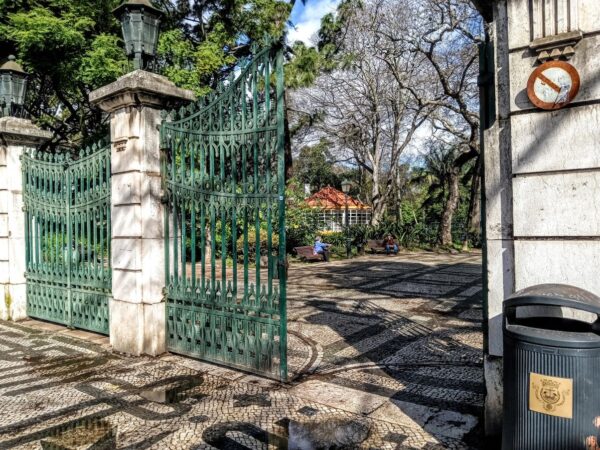
and we started immediately. (One of the advantages of taking a tour such as this one off-season is that groups tend to be smaller and, as was the case with my family’s boat trip at Benagil, we were the only three on this tour. This allows for much more personal attention and interaction with the guide.)
You who sit with us, You who share with us
We started our tour in the park at the Banana Café (which you can see in the background of the photo above) where Ines shared a substantial history of how Portugal not only spread its food traditions across the globe but also added new ones to its own and then spread those foods and cooking methods all throughout their Age of Exploration in the sixteenth century and beyond. You might recall, for example, that I wrote in this post that thanks to the Portuguese, there’s an awful lot of coffee in Brazil. As we’ll learn throughout the day, the Portuguese did more than carry coffee from Africa to Brazil.
We started our long day of walking and eating with bica (the Portuguese version of espresso and which I also discussed in the post linked above) for K & P and chá preto (black tea) for me, savory triangular filled pastries called chamuças, and sweet Jésuitas – a Doces Conventuais (convent sweet).
Since you can read about bica in the post linked above, I’ll skip it and start with a brief pronunciation lesson: the first food item is pronounced “sha-MOO-sah”. If you now hear a connection between it and samosa – a dish found in many Indian restaurants – you can take home a small prize.
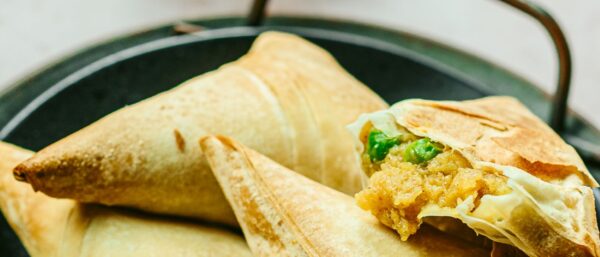
(From Continente.pt)
The Portuguese didn’t invent samosas. For that, credit belongs to the ancient Persian sanbosag and it was likely traders from central Asia who introduced it to the Indian subcontinent. What the Portuguese added to the savory mix was potatoes (from their secret trading expeditions in South America) and the green chili pepper.
(The chili pepper also likely reached India after Vasco da Gama successfully navigated the Cape of Good Hope in 1498. Of course, this also stemmed from more South American secret trading since the plant originated in the Americas. Under the leadership of Afonso de Albuquerque, the Portuguese took control of Goa in the center of India’s spice rich Malabar Coast. By 1500, Portuguese officials in Goa were reporting that Indian cooks were incorporating the new spice into their already pungent cuisine.)
The Banana Café in the Jardim da Estrela is among the largest quiosques you’ll see in Lisboa and you will see quiosques all over the city – an aspect of the city that has waxed and waned since the first quiosque appeared in Rossio Square 1869. Many serve alcohol and some, like the Banana Café or the Time Out Quiosque near the Mercado da Ribeira have a wider menu that includes sweets, sandes (sandwiches), and savories. Typically when they serve chamuças, they are filled (as ours were) with spinach or chicken and they often use the more Spanish term empanada.
The first tangent
I’ll incorporate bits of the history we learned from Ines throughout this recounting of the tour but I’d like to start with this surprising detour: The Japanese might have perfected tempura but the Portuguese invented it.
Portuguese explorers and traders reached Nagasaki in 1543 bringing with them not only tradeable spices but also their own traditions and, of course, Jesuit priests to attempt to convert as many Japanese as possible to Catholicism. In sixteenth century Catholicism, consumption of meat on Friday was forbidden.
Of course, the Portuguese ate (and still eat) copious amounts of fish but they also eat vegetables and the pole bean was among their staples. However, they didn’t like to eat them raw so they would dip them in batter and fry them calling the result peixinhos da horta or little fish from the garden.
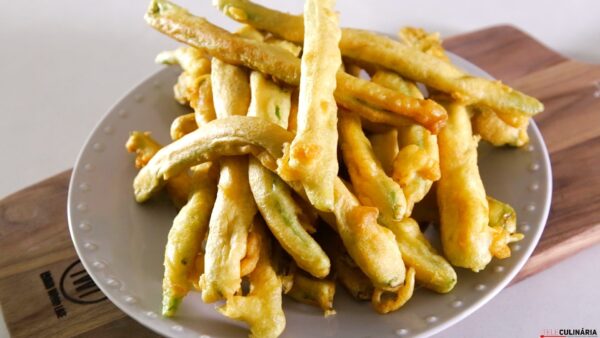
(From baracawine.pt)
As any non-native Portuguese speaker likely would, the Japanese found peixinhos da horta a bit of a mouthful. However, the Portuguese used the Latin word for “time” to describe their day of abstention from meat. That word is tempora (stress on the first syllable) – a word that with a slight alteration in the pronunciation of the second vowel – becomes tempura.
Now, on to the Jésuitas.
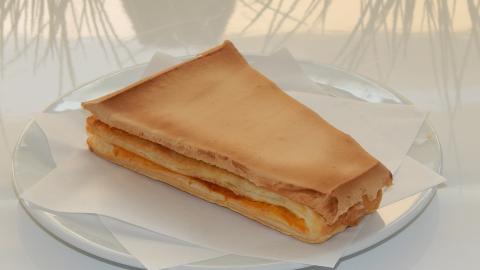
(From Sagredosdosaber.com)
As did the nation, Jésuitas originated in Portugal’s north. In fact, it’s generally believed that they were first created in the town of Santo Tirso about 30 kilometers northeast of Porto. It’s also believed that it was a Spanish pastry chef who brought the form from the city of Bilbao.
As you can see from the photo, Jésuitas generally have a triangular shape that likely drew their name from their resemblance to the frocks worn by Jesuit priests. Like many Doces Conventuais, this sweet relies heavily on egg yolks. Why egg yolks and not the whole egg you wonder? Or perhaps you’re not wondering but merely anticipating that I’m going to tell you regardless. Or perhaps you’ll skip this digression altogether.
A second tangent
Several circumstances created Portugal’s egg yolk excess and they often emanated from various religious orders. So why were these religious orders separating eggs (which were often donated by local famers who were perhaps seeking salvati0on through surplus) into yolks and whites. Well, they used the whites in several ways. First, they were an effective way to starch and maintain their white religious habits, frocks, and other clothing. Second, they were used as a glue when they decorated altars and other religious ornaments in gold leaf. Finally, they used it as a fining agent to filter wine.
Today, unless one is part of the “natural” foods movement, when we pour a glass of wine we would be shocked if our glasses contained a cloudy wine with fragments of grape pulp, suspended particles of dead yeast cells, stems, or other particles floating in it and looking a little like this photo for Joealmighty01 on the R/wine Reddit
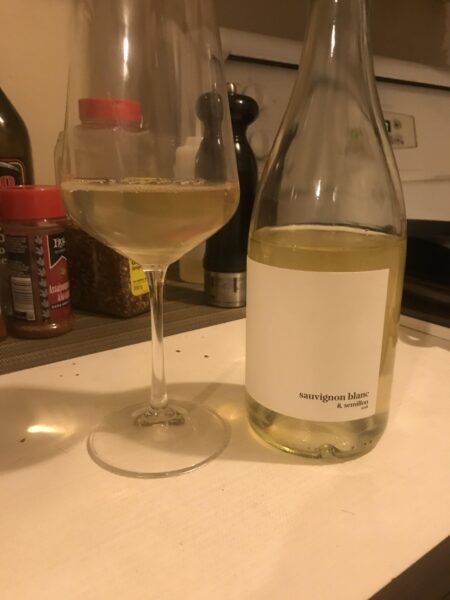
especially when we expect a Sauvignon Blanc to look more like this one from smallwinemakers.ca
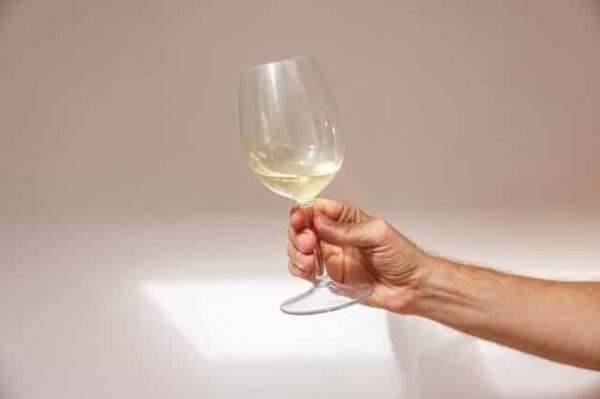
We might think the cloudy wine was cheap or unfinished and be reluctant to drink it.
Today, according to the Australian Wine Research Institute, the most common agents used in fining wine are gelatine, isinglass, egg white, casein, skim milk, bentonite, carbon, and Polyvinylpolypyrrolidone or PPVP. They state that, “The purpose of adding a fining agent preparation to wine is to soften or reduce its astringency and/or bitterness; remove proteins capable of haze formation; or reduce colour by the adsorption and precipitation of polymeric phenols and tannins. The fining agent reacts with wine components either chemically or physically, to form a new complex that can separate from the wine.” Generally, it requires three to eight egg whites to clarify a 225 liter barrel of red wine.
Wine has a long history in the rituals of Catholicism and is an essential part of Communion. Thus it makes sense that religious orders would produce their own wine but one might also wonder why they’d be concerned about its clarity. The answer is simple and apparent. They sold the wine they didn’t keep or use for themselves. And because it would have been wasteful to discard the yolks, they began finding their way into the Doces Conventuais – another product the religious orders could sell to support themselves. We’ve already met the pastel de Belém (and its stepchild the pastel de nata) and we’ll encounter another eggy dessert later on this tour.
But to do that, we need to leave the park and set out for the neighborhood of Campo de Ourique.
Deep fried batter dipped green beans- I’ve had them before Todd.
The egg white filtering agent for wine- I did not know this entertaining fact.
Funny you should mention- this line however:
“Portuguese explorers and traders reached Nagasaki in 1543.”
I am currently watching FX channel presentation of “Shogun” based on the James Clavel 1980’s novel on Tues, nights 10pm which IS way past your bedtime.
They eat a lot of seafood- but good to great crabcakes come from the Cheasapeake Bay and those who know how to prepare them.
I read Clavell’s novel and remember the 1980 Richard Chamberlain / Toshiro Mifune adaptation. The new one airs at a time that’s definitely past (but not way past) my bedtime.
I hope you liked those peixinhos da horta and are maybe a little surprised to learn that tempura is Portuguese not Japanese in origin!